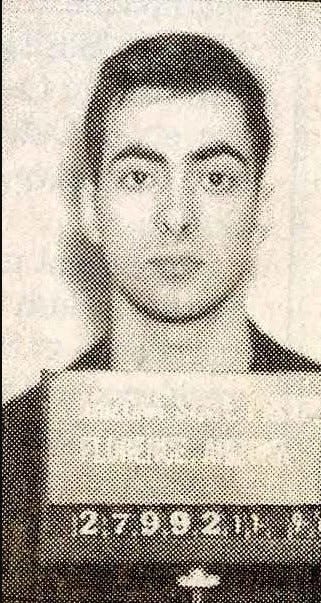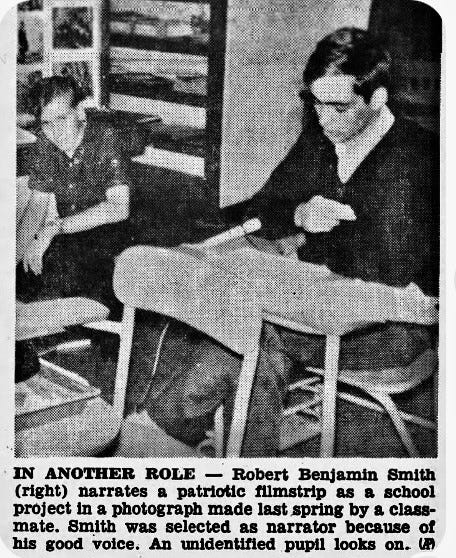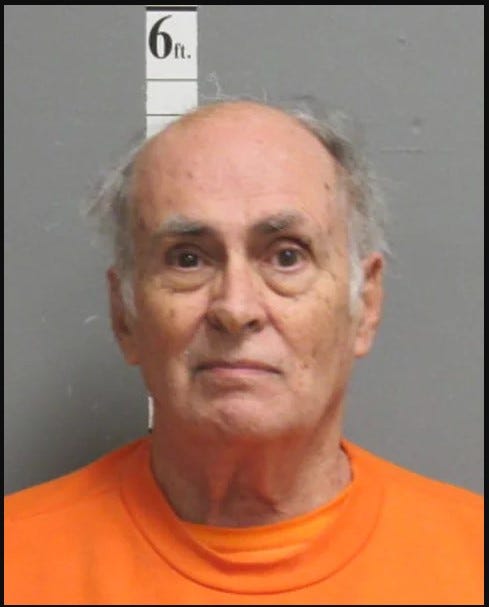
Little known convicted mass murderer is dead at the age of 76. At eighteen, Robert B Smith was sentenced to life in prison for four counts of murder and two counts of assault with murder intent. In February, he became unstable on his feet and sustained a head wound after a fall in his cell. He was transferred from Red Rock Prison to Abrazo West Campus Hospital and died on April 21st, 2024.
Benny, as his parents called him, was born in Houston, Missouri on Feb 10th, 1948. Robert Sr worked in a mechanical plant for the weekly newspaper owned by his sister’s husband. Benny strongly resembled his stay-at-home mom, Jessie.
His father was recalled to the Air Force when the Korean War began in 1951 but was luckily not required to travel outside of the USA. In order to stay close to his small family, he moved them from military base to military base with him.
“Benny started school at six years old and promptly hated it”, his mom said. “He tried persistently to miss the bus, and one day Jessie heard him phoning the school to report, “I’ve chickened out today.” His father said, “He was always a very quiet little boy”.
When Benny was eight his father was sent to Iceland for a year. Upon his return he was shocked to find Benny had become too much of a mamma’s boy. Benny was unable to tie his own shoes and had to repeat the third grade. Robert Sr accused Jessie or being overly affectionate to the boy.
In November 1960 his parents gave birth to his little sister, Lisa. This may have been the turning point for 12-year-old Benny, as he became more of a loner. His parents doted on the newly born girl as he withdrew from family events. The grudge he held against his sister would never change.
In ten years, the family moved almost a dozen times. Alabama, Colorado, Virginia and finally to Maryland.
Benny’s grandmother died of cancer in early 1961. They had become close while his father was away in Iceland. He was now used to the routine of working to make friends at a new school only to lose them when they moved. Now his grandmother is gone. Benny did not have any friends to share his worries and retreated to his room more often. This is the first time he contemplated suicide.
In 1962 the Smiths settled for a time outside of Baltimore in the picturesque town of Glen Burnie. Benny excludes himself from other students at his school and becomes convinced they are laughing at him.
In 1963, Benny demands to attend the funeral of John Kennedy but only manages to have his father take him to a local service at the air base chapel. He started to collect anything he could find about the assassination. Pictures, book, photos and articles. It is only later that his parents realized that the material was as much about Lee Harvey Oswald as it was about Kennedy.
“I didn’t know until I examined it much later that he had as much on Oswald as he did on John Kennedy.” His mom said, “It seems that Oswald suddenly became a hero to him instead”.
He would spend hours alone in his room contemplating life staring at a photo of Baron von Richtofen (The Red Baron) he kept next to his bed. On occasions, Benny would disappear on the bus to the Smithsonian Institute and troll around the exhibits on his own. A fond memory he would keep the rest of his life.
The Smiths moved to Mesa, Arizona in early 1965 (about 25 miles from Phoenix and with a population of about 50,000). The father decided to put down the elderly family dog because it was too old to make the trip. Benny was gutted. Robert Sr retired from the Air Force and was working in an aerospace plant outside of Phoenix.
Benny tried his best to fit in and auditioned for the high school dramatic society. He landed a major role in a play but refused to let his parents attend the performance. Later that year he went on his first date with a mate Bill and his gal. He sat sheepishly in the back seat with a girl so heavily made up and hair creatively teased into a beehive, that he froze. He didn’t know what to do and swore he would never date ever again.
In the summer of 1966, Benny embarked on a trip to Southern California with an adventurous new friend named John. It was unheard of for Benny to travel so far away and with someone the parents did not know. Robert Sr felt it was a great idea and was pleased to see Benny showing some backbone. Mom wasn’t so sure. Sadly, the pair ended their trip early and cancelled their friendship. Neither will talk about what happened that week.
By the start of the 1966 school year, Robert (taking a more adult name) was a high school senior living with his family on East Seventh Drive. He now using a rubber ball as a tension toy in his room, bouncing it furiously when he was agitated. Little Lisa was just about to start first grade and the rest of the Smiths appeared to be settled and happy.
A classmate described Robert as a “loner” or “introvert”, the kind of “kid that nobody knew”. A teacher said he excelled at science and math but was unable to complete the simplest of physical tasks. After a year of tumbling, he could not do a simple roll. A coach said he still could not bring the bat back far enough to make a decent swing, after a season of baseball.
His best friend said he idolized Napoleon and Jesse James and followed the conflicts in Southeast Asia very closely. He said Robert was convinced the US Army would use germ warfare on civilians and “wipe out the people” in the region. Local newspapers would soon describe him as “pasty faced, 150-pound youth” who perpetrated the “worst crime in Arizona history”.
Robert was a straight A pupil in an advanced learning class of just thirteen students. He was handsome, well-groomed and recently elected to the student council that Autumn.
On Saturday Nov 12th 1966, Robert packed a brown paper back with plastic sandwich bags, 200 feet of nylon cord, two hunting knives and a .22 calibre handgun with extra rounds. His parents had bought him the pistol a year before for target practice in the backyard.
At about 6:30am, he started the mile and half walk to the business district of the small town. Just the evening before he was helping his six-year-old sister with her letter to Santa and chatting to his parents. He retired early to his room telling his parent he had to get up early the next morning to help build a Thanksgiving Day float at school. His parents did not see or hear him leave the house the following morning.
He had been planning an evil murder for some months and was inspired by the heartless acts of Richard Speck and Charles Whitman the previous summer. In Chicago, Speck ruthlessly stabbed eight nursing students over three hours in the middle of the night. Whitman stabbed his mother and wife to death as they slept leaving his suicide note. The following morning, loaded with an arsenal of weapons, he used a fake ID to gain access to the clock tower at the University of Texas. He shot down upon innocent people, killing seventeen and injuring thirty-one. Whitman was killed at the scene while Speck was convicted and seemed to enjoy the rest of his life in prison.
Robert wandered the streets of Mesa looking for the perfect target. He walked past a pizza place, an elementary school and a beauty shop but none of them had enough occupants at that time of the morning. He was struggling to find a place with the right number of customers, when he came across Rose-Mar College of Beauty.
Robert peered inside the window of the small one-story building and saw a few young ladies wandering about. He noticed the school was set to open after 8am and decided to wait around to see if more victims would turn up.
The college director had arrived about 15 minutes earlier and found people waiting on the doorstep. She opened the door so they could begin setting out their supplies and readying their stations for the day. The phone rang and the director disappeared into her side office to answer it.
As he watched from the parking lot, a woman with two small children drove up and went inside. He quickly dashed in behind them and revealed a gun from the sack.
None of the women inside took him seriously until he fired his weapon into a large plate glass mirror covering the wall. Through the office window, the college director looked up to see a man walking down the centre of the beauty stations. She heard the shot and exited through the side office entrance. She phoned the police from the auto supply store next door.
Robert ordered the five women and two children into the large demonstration room in the back of the building. He demanded they form a circle on the floor, face down with their heads in the center and feet facing the perimeter of the room.
The seven victims were directed to lay still and keep quiet as he walked around this “wheel of death”. One of the victims, Joyce Sellers held her three-month-old daughter in her right arm while tightly squeezing the older sister (three) with her left hand.
One victim told him, "There'll be forty people here in a few minutes." He replied, "I'm sorry, but I didn't bring enough ammunition for them."
Robert tied up the women with the nylon cord but suddenly realised his plastic bags were too small to go over their heads. He paced around the women on the floor trying to decide what to do. Suddenly, he began to shoot each victim in the head, one by one, reloading three times. He said he did not expect to see any children but shot them anyway.
Joyce Sellers managed to shield the infant and preserve her life but sadly she was unable to save her older daughter and herself. Her three-year-old was horribly wounded and attempted to run for safety when Robert stabbed her to death with one of the hunting knives. Eighteen-year-old college employee, Bonita Harris, played dead as she watched Robert laughing while pulling the trigger. She also heard the killer mutter that nobody cared for him as if this act was some form or retribution.
When the police arrived at the scene, they saw a man through the glass door. He was standing still and looking out the window. “I shot some people” he told the arresting officer. “They’re back there. The gun is in the sack”. They quickly apprehended him and found the brown paper bag on a waiting area chair, with the murder weapons inside.
The young killer showed no remorse and offered no explanation except announcing, "I wanted to get known, just wanted to get myself a name". The police asked him to reconstruct what had just occurred. He obliged and took the stunned officers on a tour of the bloody crime scene as bodies were being carried out.
“I wanted to see the headlines with my name in them before I die."
Five of the seven victims lost their life that morning. Both survivors were rushed to Mesa Southside Hospital. Bonita Harris was treated for a gunshot wound to her head and arm with the infant treated for a very serious skull fracture and large wound to her upper arm.
Robert Sr woke that morning to find his son’s bedroom empty and went to look for him at the school. A few hours later he swung by the Police Station to report him missing and was told his son was in custody. Robert Sr replied, “I was afraid of that”. Clearly the parents knew that things were not good with their oldest child.
It was reported that his school planner contained an indication of what was to come. Robert had apparently written “Slaughter on a Saturday” and scribbled a large “X” through the entire day of Nov 11th. I was unable to find any valid reference for it other than a psychology report, so asked Robert directly. He said, “Why would I write that?”
Robert would later tell a psychologist, if my mother and six-year-old sister would have walked in during the killings, “I would have killed them too.”
He worked hard to prove he was of sound mind, destroying his lawyers attempt to sway the jury towards insanity. “My attorney is trying to make everyone on the outside think I’m insane”, he wrote to a jail mate.
Robert was found to be sane and was eventually convicted after one of the longest trials in Arizona history. After the thirty-three-day trial, the jury took less than two hours to make their ultimate decision. He was ordered to die by lethal gas but later commuted to serve the rest of his life in prison.
In 1971 he wrote this to his parents: “There are some things that are easier to say on paper than in person — things that I’ve wanted to say for a long time. I’m sorry for what I’ve done to hurt you. You deserve a better son than me — and that’s for sure. I love you both very much — always have and always will. And I want you to tell Lisa that I love her, too.”
While inside he befriended many of Arizona’s most notorious killers including the infamous Pied Piper of Tuscan, Charles Schmid. Robert was asked to accompany Charlie on one of his attempted escapes. Robert declined but was surprised that he actually made it over the wall, only to be returned to his cell a few days later. Charlie was savagely murdered by another inmate in 1975.
Robert would brag about how much they got away with while the guards weren’t looking. Back in the late 70’s and early 80s, he had a long-term relationship with a mature law student who came for conjugal visits. The two of them could be seen under a blanket in the yard or holding hands and walking the fence line. She cut off the relationship without warning which was exactly what Robert expected.
Robert was psychopathically evil and there seems to be little debate surrounding that. A debate may come from whether it is OK to like him. He was overtly evil but also human. Evil humans can be interesting and I found him to be fascinating. But I will never forget the pain and suffering he caused so many.
Robert was a man I got to know while he was locked up at Red Rock Prison. He was quite a character, a Hannibal Lecter type, who loved to quote Monty Python and recite lyrics from jazz standards. I enjoyed getting messages from him or chatting to him on the phone. I often had to repeat myself with more volume because of his poor hearing.
His parents died many years ago and his sister sadly passed away in early 2022. Towards the end of his life, he continually asked for images of Gillian Anderson and videos of BBC’s Lucy Worsley. He loved to watch them both on BBC America.
Robert openly admitted he had issues when in the company of the opposite sex. He said he was unable to say ‘no’ and crumbled in their presence. According to him, a ‘well equipped vixen’ convinced him to hand over his power of attorney. He said he was powerless to stop her from taking the inheritance his sister had left him. “Maybe this was some kind of justice”, Robert told me.
His body will be cremated and probably concealed in a numbered grave on the grounds of a correctional facility. Perhaps they will lay him next to his old buddy, the Pied Piper of Tucson, in the Florence State Prison’s makeshift cemetery? Or perhaps the ‘vixen’ will use his funds to give him a proper burial, unlike his sister.
Does it really matter? Robert Benjamin Smith can now be forgotten. Exactly as he wanted. Despite committing the most horrendous of acts to make a name for himself, in the end, he did not want to be remembered
.















I was in 6th grade when he killed those women and the little girl. It shocked our community. Kids I went to school with knew the victims, went to church with Mrs. Sellers. We all went to that beauty college to get cheap hair cuts. I'm glad to know he is finally gone from this world.
I've wondered about this guy from time to time. What did his parents and sister do in their lives ? How did you get to know Robert ? He must have been one of the longest serving prisoners in Arizona.